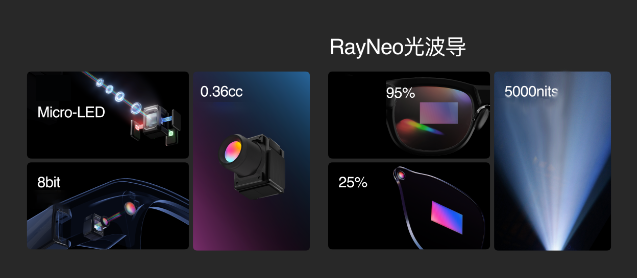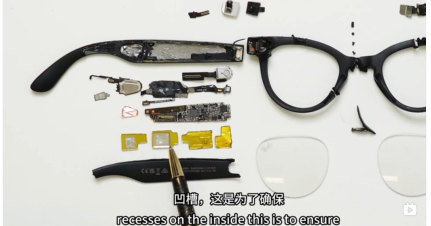Why AI smart glasses become a hit in 2025: Why Flex PCB becomes a key technology?
CES 2025 has officially started on January 7, Pacific Time, USA. As a global consumer electronics weathervane, AI has become the theme of this event. "AI" is called the mainstay of CES 2025.
Many new AI wearable devices were unveiled at CES. AI smart glasses also attracted everyone's attention.
These products not only emphasize AI technology, but also usher in upgrades in optical display, audio technology and other aspects.
XREAL showcased the company's latest XREAL One series, equipped with XREAL's self-developed chip customized for OST AR glasses-X1 spatial computing chip. The modular AI camera XREAL Eye also appeared at the exhibition site. The product can take photos from a first-person perspective.
Thunderbird Innovation officially released the new generation of Thunderbird V3 AI shooting glasses at CES, priced at 1,799 yuan and weighing 39 grams.
As an AR smart glasses, AR optical display technology is the highlight of Thunderbird V3 AI shooting glasses. Official introduction, V3 AI shooting glasses are equipped with RayNeo waveguide + MicroLED light engine. Thunderbird's self-developed full-color MicroLED Light engine - Firefly light engine, with a volume of only 0.36cc, is the smallest color light engine in the industry. Compared with the traditional double-layer waveguide, RayNeo waveguide can reduce the product thickness by 0.6mm and the weight by 25% after the single-layer full-color technology is added, achieving a peak brightness of 5000nits.
At CES2025, Li Weike demonstrated the company's upcoming new AI smart glasses Meta Lens View, the main function of which is high-definition shooting and content sharing. Electronic enthusiasts learned that the new product will be equipped with the first-generation Snapdragon AR1 platform and Sony IMX681 chip, and the weight will be controlled within 40g.

These smart glasses, as one of the most promising innovations in technology products, are becoming more and more eye-catching in the market. Do you know? Behind everything, the emergence and development of Flex PCB (flexible printed circuit board) technology is one of the key factors driving the rapid development of this emerging industry.
The key words we mentioned above for the products are weight. Every AI smart glasses company tries to reduce the weight and volume of glasses as much as possible.
1. Behind the rise of AI smart glasses
In terms of AI, we cooperate with Ali Tongyi to create a large AI model dedicated to smart glasses. The average response speed of AI is 1.3s, and functions such as RayNeo Radio, mobile phone notification AI summary broadcast, AI news podcast, and Zhi Xiaobao scan code payment will also be launched.
In terms of photography, Thunderbird V3 AI shooting glasses use Sony IMX681 COMS, equipped with an exclusive customized Falcon optical lens, 16mm wide angle and F2.3 large aperture. Equipped with Qualcomm Snapdragon® AR1 flagship chip and ArcSoft's algorithm, the overall image performance is improved. In terms of audio, the 9*20mm customized speaker of AAC Technologies is used.
Gyges Labs (formerly Shenzhen Xianshun Technology Co., Ltd.) is headquartered in Singapore. The company has successfully developed the world's smallest near-eye display optical system: Digi Window. At CES 2025, Gyges Labs and moody jointly launched Halliday, an AI smart glasses developed based on Digi Window technology. Unlike the AR smart glasses that use waveguide lenses commonly seen in the industry, the optical display system of the AI smart glasses launched by Gyges Labs is located above the right frame, which can project information into the user's field of view instead of into the lens, so it can be used without lenses.
In addition, the glasses are equipped with a microphone and also have AI assistant functions, weighing about 35 grams. The price is about US$399 to US$499. It will be officially shipped in the first quarter of 2025. We can see that these glasses equipped with microphones, image cameras, and top-level chips need to be concentrated in a 30-40g pair of glasses, so neither the components mentioned above nor the PCB boards carrying them can be too large or too heavy, and the only options for such glasses merchants are IC or Flex PCB.
2. Why Flex PCB?
As a highly integrated wearable device, the circuit board (PCB) design of AI smart glasses is crucial. Usually, such devices use flexible printed circuit boards (FPC) to meet the needs of miniaturization, lightweight and complex three-dimensional wiring. FPC has good flexibility and foldability, which is suitable for the narrow space and curved surface installation requirements of smart glasses.
In addition, micro connectors also play an important role in AI smart glasses. For example, the micro connector product line of ELECTRONICS covers RF connectors, antennas, board-to-board connectors, wire-to-board connectors, FPC connectors, etc., which are widely used in smart wearable devices, VR and AR and other fields.
Therefore, the PCB design of AI smart glasses usually adopts flexible printed circuit boards (FPCs) and combines micro connectors to achieve miniaturization, lightweight and high performance of the equipment.
Flex PCB uses a flexible substrate that can be easily bent and folded without sacrificing electrical performance. This is a perfect solution for smart glasses that need to have both compact design and high performance.
3. The impact of Flex PCB on the design of AI smart glasses
The emergence and development of Flex PCB (flexible printed circuit board) technology is one of the key factors driving the rapid development of the emerging industry of AI smart glasses design. Flex PCB provides great flexibility and innovation space for the design of AI smart glasses, which is mainly reflected in the following aspects:
1) Lightness and portability
As a wearable device, smart glasses are extremely comfortable and portable. Traditional rigid PCBs make the circuit board bulky and affect the lightness of the glasses. The flexible characteristics of Flex PCB allow the circuit board to be designed into a very thin structure that fits the curve shape, greatly reducing the weight of the glasses and improving the comfort of wearing.
2) Integration of complex circuits
Smart glasses need to integrate a large number of electronic components, such as display modules, sensors, cameras, processors, communication modules, etc. Flex PCB technology enables designers to cleverly embed these complex components into various positions of the glasses frame without worrying about the rigidity and space limitations of the circuit board. This not only optimizes the utilization of internal space, but also improves the integration of the system and reduces redundant circuits.
3) Shock resistance and durability
Smart glasses need to have strong shock resistance and durability, especially in outdoor sports or mobile use scenarios. Flex PCB has better impact and vibration resistance, and can ensure the stability and long-term reliability of the circuit board when the glasses experience bending, collision and other situations in daily use.
4) Higher thermal management capabilities
With the improvement of AI processing capabilities, the heat generated by chips and processors in smart glasses is gradually increasing. Flex PCB can design thermal management systems more flexibly and effectively distribute heat dissipation, improve the heat dissipation efficiency of circuit boards, and prevent overheating from causing performance degradation or damage.
In recent years, with the improvement of semiconductor technology and manufacturing processes, Flex PCB has been increasingly used in smart wearable devices. In particular, with the continuous improvement of the integration of AI chips and sensors, the requirements for PCBs are also increasing. By optimizing materials and processes, Flex PCB has significantly improved its performance in high temperature resistance, anti-interference, signal transmission efficiency, etc., which can meet the needs of smart glasses for high performance, low power consumption and long battery life.
For example, double-sided Flex PCB (that is, both sides of the circuit board have wiring) and multi-layer Flex PCB (multiple flexible circuits are stacked together) technologies allow designers to integrate more functional modules in a limited space. This makes AI smart glasses not only have a breakthrough in performance, but also can be optimized in size and weight, thus meeting consumers' needs for portability and comfort.
4. The reverse driving effect of AI smart glasses on Flex PCB
In recent years, with the improvement of semiconductor technology and manufacturing processes, Flex PCB has been used more and more widely in smart wearable devices. In particular, with the continuous improvement of the integration of AI chips and sensors, the requirements for PCB are also increasing. By optimizing materials and processes, the performance of Flex PCB in high temperature resistance, anti-interference, signal transmission efficiency, etc. has been significantly improved, which can meet the needs of smart glasses for high performance, low power consumption and long battery life.
For example, double-sided Flex PCB (that is, both sides of the circuit board have wiring) and multi-layer Flex PCB (multiple flexible circuits are stacked together) technology, allowing designers to integrate more functional modules in a limited space. This makes AI smart glasses not only have a breakthrough in performance, but also can be optimized in size and weight, thus meeting consumers' needs for portability and comfort.
By 2025, AI smart glasses are expected to become a new hot product in the field of smart hardware. As the technology matures further, Flex PCB will provide more stable and efficient support for smart glasses, enabling them to better meet the needs of daily use. In the future, smart glasses will not only be a display screen, but may become a multifunctional device that integrates multiple functions such as virtual reality, augmented reality, navigation, health monitoring, language translation, etc.
In addition, with the popularization of 5G technology and the improvement of AI computing power, the real-time data processing and interactive experience of smart glasses will be greatly improved. Users can enjoy a seamless smart life experience without relying on mobile phones. By then, Flex PCB will continue to play an important role in promoting innovation in smart glasses, improving product performance, and reducing costs.
The following is a disassembly of ai glasses. If you are interested, you can click the link to watch (^-^)~

https://www.youtube.com/watch?v=SbTc-a29dUQ





